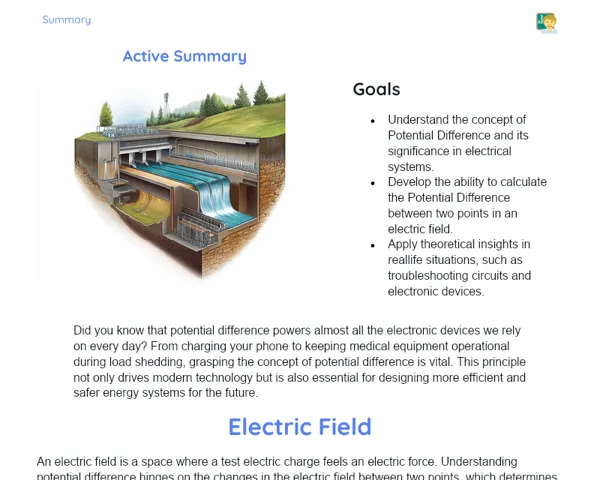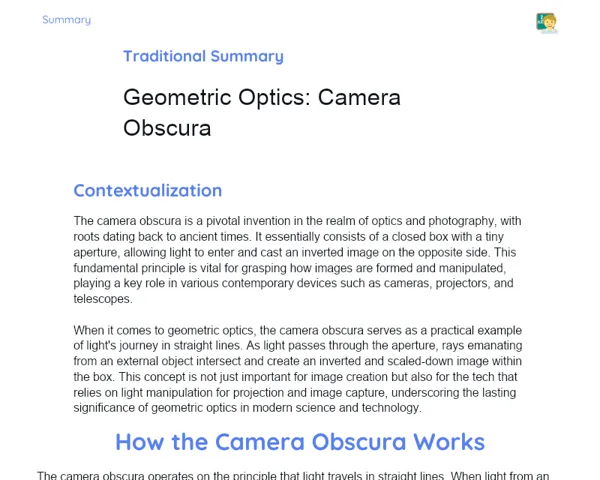Objectives
1. 📡 Understand sound intensity as a measure of the energy carried by sound waves per unit area over a set time.
2. 📡 Get to grips with calculating sound intensity using the right formula, while exploring how various factors influence this intensity.
3. 📡 Use theoretical knowledge in hands-on experiments and activities that mimic everyday situations like concerts and work settings.
Contextualization
Did you know that sound intensity isn't just a textbook concept but one that impacts our daily lives? From the booming volumes at music festivals to the bustling noise of city life and the wail of emergency sirens, comprehending sound intensity is vital for safeguarding our hearing and for various applications, such as acoustic engineering and healthcare. Throughout this exploration, we will delve into the realm of sound waves and discover how sound intensity affects our experiences at concerts and even our safety at work.
Important Topics
Sound Intensity
Sound intensity is a measure of the acoustic power a sound wave has per unit area perpendicular to its direction. It’s measured in watts per square meter (W/m²) and directly correlates to how loud a sound is perceived. Grasping sound intensity is key to understanding how various noises can impact our hearing and surroundings.
-
Expressed in watts per square meter (W/m²), sound intensity is essential for calculating decibel levels.
-
Sound intensity diminishes as the distance from the source increases because the sound energy is spread over a larger area.
-
Variations in sound intensity can affect our perception of sound and our auditory health, with high levels potentially causing irreversible hearing damage.
Decibels (dB)
Decibels are a logarithmic unit used to describe the relative intensity of sounds. The decibel scale mimics how our ears perceive sound, as this response is more logarithmic than linear. This means that a 10 dB increase equates to roughly doubling the perceived sound intensity.
-
The decibel scale is handy for comparing the sound intensities of different sources, including industrial settings, urban environments, and musical performances.
-
Decibel levels above 85 dB can harm hearing if one is exposed for too long, making the management of sound intensity critical in workplaces and during leisure.
-
Adding decibels isn't a straightforward process: a 10 dB rise is generally perceived as doubling the sound level.
Sound Intensity Formula
Sound intensity (I) is derived from the formula I = P/A, where P represents the total sound power from the source and A is the area over which that sound energy spreads. This formula allows us to quantify sound intensities under various scenarios, which is crucial for defined applications and safety standards in loud settings.
-
Sound power (P) indicates the overall energy emitted by a sound source; this is vital for calculating decibel levels.
-
The area of propagation (A) directly influences sound intensity, where sounds concentrated in smaller areas show higher intensities.
-
A strong grasp of this formula is essential for professionals in acoustics, from engineers to sound technicians.
Key Terms
-
Sound Intensity: The measure of acoustic power per unit area perpendicular to the direction of sound travel.
-
Decibels: A logarithmic unit used to indicate the relative intensity of sound.
-
Sound Power: The total energy emitted by a sound source.
-
Propagation Area: The surface over which sound energy disperses, impacting sound intensity.
For Reflection
-
How does sound intensity vary in different places, like a closed room versus an open area? Consider how this affects our hearing experiences and health.
-
How can understanding sound intensity be used to enhance the acoustics in public and private spaces, taking into account the necessity for acoustic comfort?
-
Imagine a situation where controlling sound intensity is crucial for people's safety or health. How would you propose managing this in such a scenario?
Important Conclusions
-
We dove into the concept of sound intensity and its significance, not only physically but also in our everyday and professional lives.
-
We reviewed the formula used to calculate sound intensity and how it relates to decibel levels, crucial for understanding the effects of sound on hearing and overall health.
-
We emphasized the practical applications of sound intensity knowledge in areas like acoustic engineering, healthcare, and workplace safety, illustrating its importance in various contexts.
To Exercise Knowledge
- Create a sound intensity journal: Over a week, document the sound levels you encounter in different settings, from your home and school to public places. Use a decibel measurement app to assist you. 2. Develop a noise reduction strategy: Identify a spot in your home or school that's often noisy and craft a plan to lower sound intensity in that space. 3. Play around with music: Use a sound editing app to tweak the intensity of various music tracks and see how it impacts your feelings while listening to them.
Challenge
Decibel DJ Challenge: Using sound editing software, make a mixtape where each song starts at a low sound level and gradually increases, without exceeding a safe decibel threshold. Share your mix with the class and discuss your thought process and intensity adjustments.
Study Tips
-
Download free decibel measurement apps to explore sound intensity across different environments and situations you encounter daily.
-
Watch educational videos or documentaries focused on acoustics and sound engineering to see how the study of sound intensity is applied in real-world and creative settings.
-
Practice calculating sound intensity and decibels using everyday examples, such as how loud a vacuum cleaner is or the sound at a live concert, to become familiar with volume metrics.



